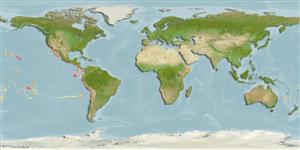Elasmobranchii (tubarões e raias) (sharks and rays) >
Squaliformes (Sleeper and dogfish sharks) >
Etmopteridae (Lantern sharks)
Etymology: Centroscyllium: Greek, kentron = sting + Greek, skylla = a kind of shark (Ref. 45335).
More on author: Garman.
Environment: milieu / climate zone / depth range / distribution range
Ecologia
marinhas bentopelágico; intervalo de profundidade 269 - 1170 m (Ref. 96339). Deep-water; 32°N - 30°S
Eastern Pacific: Hawaiian Islands, southern California (USA), Panama, Cocos Island (Costa Rica), Colombia, Ecuador, northern and central Chile, and the Galapagos Islands. Has been confused with Etmopterus granulosus (Günther, 1880) and Centroscyllium granulatum (Günther, 1887), but is quite distinct.
Tamanho / Peso / Idade
Maturity: Lm ? range ? - ? cm
Max length : 51.0 cm TL macho/indeterminado; (Ref. 96339)
A little-known deepwater dogfish found on the continental and insular slopes. Incidentally caught in sablefish (Anoplopoma) traps but not utilized. Feeds chiefly on other fishes and invertebrates (Ref. 28023). Ovoviviparous (Ref. 205).
Life cycle and mating behavior
Maturidade | Reprodução | Desova | Ovos | Fecundidade | Larvas
Distinct pairing with embrace (Ref. 205).
Compagno, L.J.V., 1984. FAO Species Catalogue. Vol. 4. Sharks of the world. An annotated and illustrated catalogue of shark species known to date. Part 1 - Hexanchiformes to Lamniformes. FAO Fish. Synop. 125(4/1):1-249. Rome, FAO. (Ref. 247)
Categoria na Lista Vermelha da IUCN (Ref. 130435: Version 2024-2)
Ameaça para o homem
Harmless
Utilização humana
Pescarias: sem interesse
Ferramentas
Relatórios especiais
Descarregue XML
Fontes da internet
Estimates based on models
Preferred temperature (Ref.
123201): 6.6 - 9.9, mean 8 °C (based on 44 cells).
Phylogenetic diversity index (Ref.
82804): PD
50 = 0.5078 [Uniqueness, from 0.5 = low to 2.0 = high].
Bayesian length-weight: a=0.00372 (0.00188 - 0.00734), b=3.10 (2.92 - 3.28), in cm total length, based on LWR estimates for this (Sub)family-body shape (Ref.
93245).
Nível Trófico (Ref.
69278): 3.9 ±0.56 se; based on food items.
Resiliência (Ref.
120179): Baixo, tempo mínimo de duplicação da população 4,5 - 14 anos (Fec assumed to be <100).
Fishing Vulnerability (Ref.
59153): Moderate vulnerability (40 of 100).
Nutrients (Ref.
124155): Calcium = 6.46 [1.11, 35.03] mg/100g; Iron = 0.217 [0.049, 0.765] mg/100g; Protein = 17.3 [15.0, 20.0] %; Omega3 = 0.292 [0.094, 0.949] g/100g; Selenium = 15.5 [3.7, 55.0] μg/100g; VitaminA = 23.9 [3.9, 143.4] μg/100g; Zinc = 0.503 [0.225, 1.077] mg/100g (wet weight);
